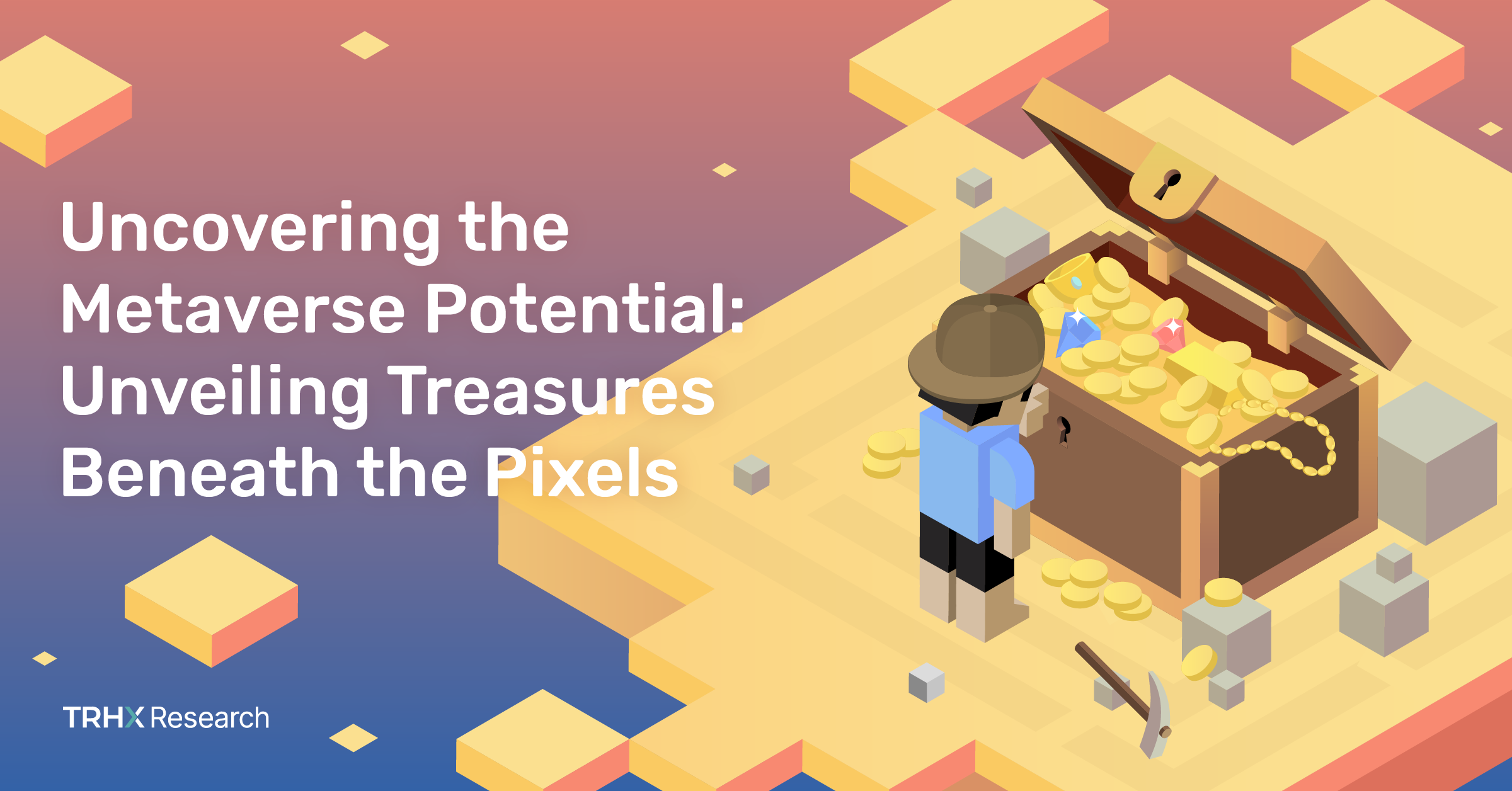State of the Market
Despite the prolonged winter that crypto has endured since the crashes of LUNA and FTX, the market is showing signs of revival. Bitcoin reached a new all-time high just a few months after the ETF approval, and Ethereum has made significant progress with its own spot ETF, which commenced trading in the US on July 23rd. However, while this renewed interest has primarily benefited Bitcoin and Ethereum, altcoins have yet to experience significant price increases, suggesting that an “Alt Season” may still be on the horizon.
GameFi is emerging as the next major narrative amid this crypto market resurgence, potentially bringing the “next billion users” into the crypto space. The integration of the metaverse into gaming, along with advancements in AI and Virtual Reality, promises to revolutionize the gaming experience. The low barrier to entry and the vast user base of traditional gamers make GameFi and the metaverse particularly attractive. As these technologies continue to develop, they will likely attract a massive influx of new users to the crypto market.
Before delving into the recent developments we are all familiar with, let’s take a trip down memory lane.
Journey of the Metaverse Concept
Remember when everyone was buzzing about JPEGs selling for millions and virtual worlds where we could live alternate lives? NFTs were all the rage—artists, celebrities, and everyday folks were diving into the actions. By 2021, NFTs had catapulted from the niche corners of the internet into the global spotlight, thanks to landmark sales such as Beeple’s artwork, which fetched $69 million. This period marked the peak of NFTs, transforming digital art into coveted treasures and creating overnight millionaires.
Around the same time, big tech companies were heavily investing in the Metaverse. The concept of the Metaverse began in the early 2000s with virtual worlds like Second Life and massively multiplayer online games like Grand Theft Auto that offered immersive experiences. However, it was the advancements in virtual reality (VR) and augmented reality (AR) technologies, along with the growing utilization of blockchain technology, that truly set the stage for the Metaverse.
This sci-fi-like concept of living in an online world with Web3 elements gained traction because it provided a way to interact and conduct transactions without the fear of double-spending problems. The mainstream acceptance of the Metaverse was epitomized by a few significant events: Facebook’s rebranding to Meta in 2022, games like Fortnite reaching mass adoption, and Web3 Metaverse projects like The Sandbox gaining sector-wide recognition. Brands began collaborating, and celebrities launched their NFTs, blurring the lines between the digital and physical worlds and promising new forms of interaction and commercial opportunities.
The concept of the Metaverse offered a compelling vision: a persistent, scalable, and interoperable environment where users can interact with digital content and each other in ways that not only parallel the physical world but also extend beyond it.
Moving Closer To The Original Vision
Fast forward to today, NFTs are finding new applications in areas like digital identity verification and copyright management. At the same time, the Metaverse concept is explored for its potential in remote work, education, and real-time collaborations. Despite setbacks from the bear market, the industry is progressing towards the vision set in 2021: creating a fully immersive, interconnected digital world where physical and virtual realities seamlessly merge. From Apple’s release of the Apple Vision Pro to Web3 pioneers like The Sandbox continually developing new digital experiences and forging more institutional partnerships, it has become clear that the Metaverse concept is evolving from its early wild days into tools that may redefine our interaction with the digital world.
As the market continues to stabilize, the true value propositions of the Metaverse, NFTs, and GameFi will become increasingly apparent, signaling a promising future ahead for this space.
Resurgence of Market Interests
Revitalizing Investor Confidence Post-Bear Market
The GameFi sector has experienced a remarkable surge in market interest throughout the past 12 months, emerging alongside the crypto majors. In the 12 months before May 2024, we have seen a substantial increase in the number of GameFi token launches on major launchpads such as the Bybit Launchpad, nearly doubling from a year ago and 5X from the market trough before Blackrock’s BTC ETF announcement.
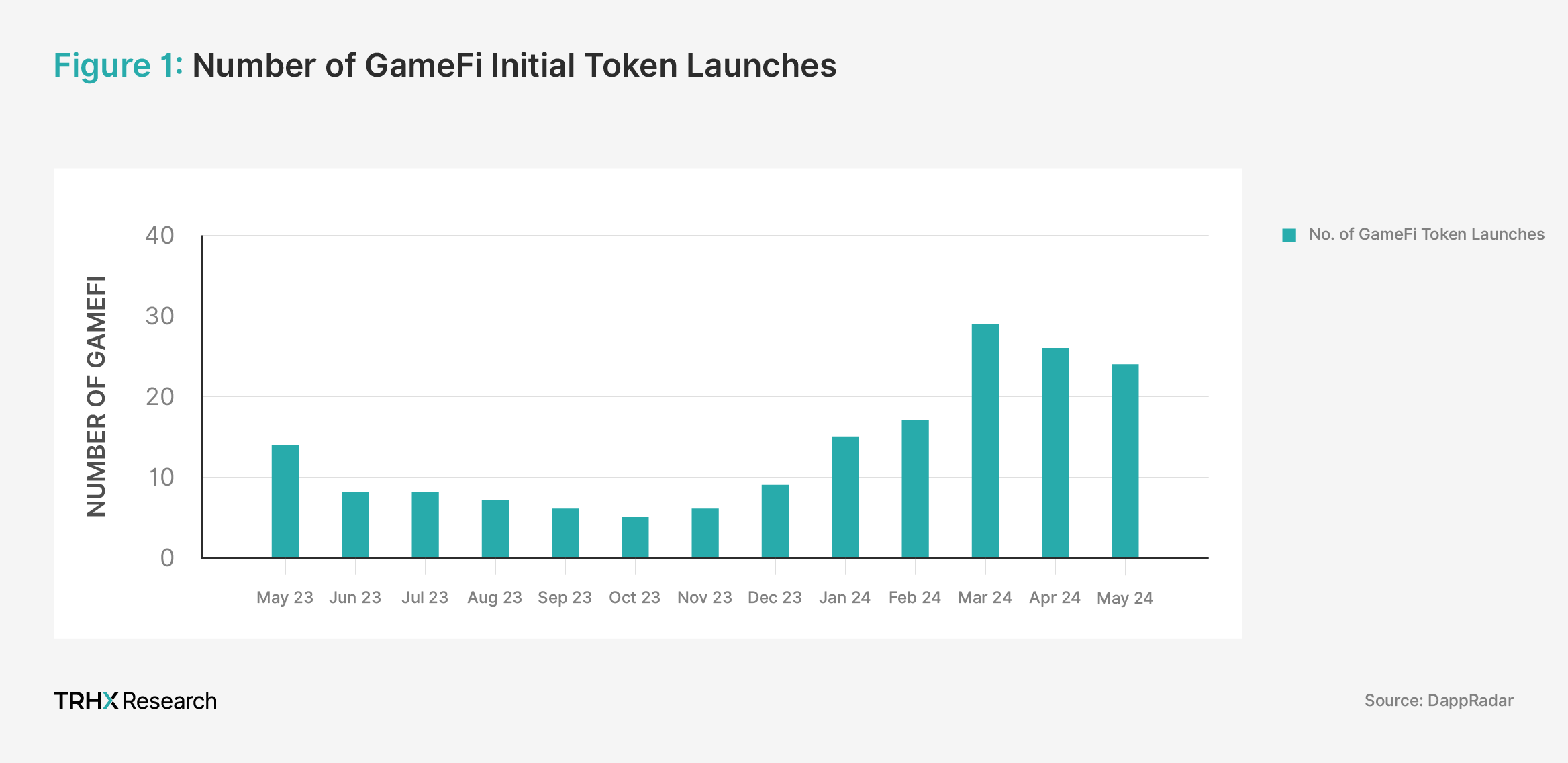
Moreover, the success of the GameFi sector is notable with outstanding performances in Initial Exchange Offerings (IEOs). For instance, 3 out of the top 5 peak IEO returns year-to-date are GameFi tokens, indicating significant retail demand and potential earnings within the GameFi sector.
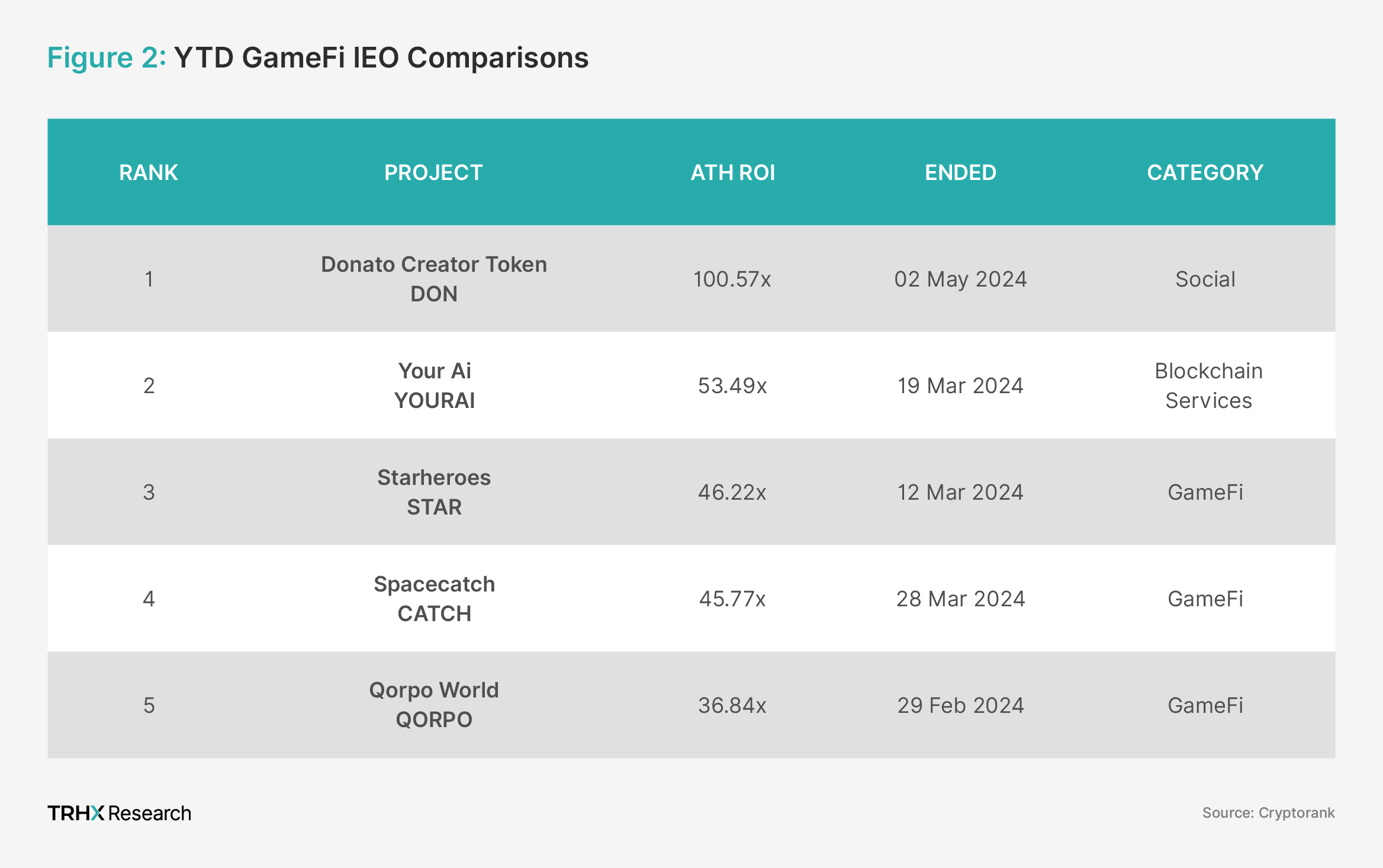
VCs’ Renewed Bet on Web3 Gaming and the Metaverse
The number of VC raises has been on a clear upward trajectory since the latter part of 2023. This surge reflects growing investor confidence and an optimistic outlook toward innovative and emerging technologies. Among the sectors attracting significant investment, Web3 Gaming and Metaverse projects stand out prominently. These projects have captured a substantial amount of investment this year, signaling a shift in focus with the crypto VCs.
Notably, The Sandbox, one of the pioneers in the metaverse gaming space, has also raised an additional $20m at a $1 billion valuation to expand its Metaverse through convertible notes, showcasing institutional investor interests. The funds will be used to enhance the platform’s Game Maker and VoxEdit 3D editor tools, introduce new social interactions for avatars, and expand multiplayer gameplay options. The beta version of these updates is expected to be launched later this year, with a public release in 2025. Additionally, a mobile version of The Sandbox is in development for 2025.
All of this points towards the conclusion that institutional investors view Web3 Gaming and Metaverse projects as promising avenues for substantial returns. The convergence of gaming and blockchain technology in Web3 Gaming presents new opportunities for decentralized ownership, in-game economies, and player-driven content creation. Similarly, the Metaverse’s potential to create immersive virtual environments for social interaction, commerce, and entertainment is seen as a frontier with vast monetization possibilities.
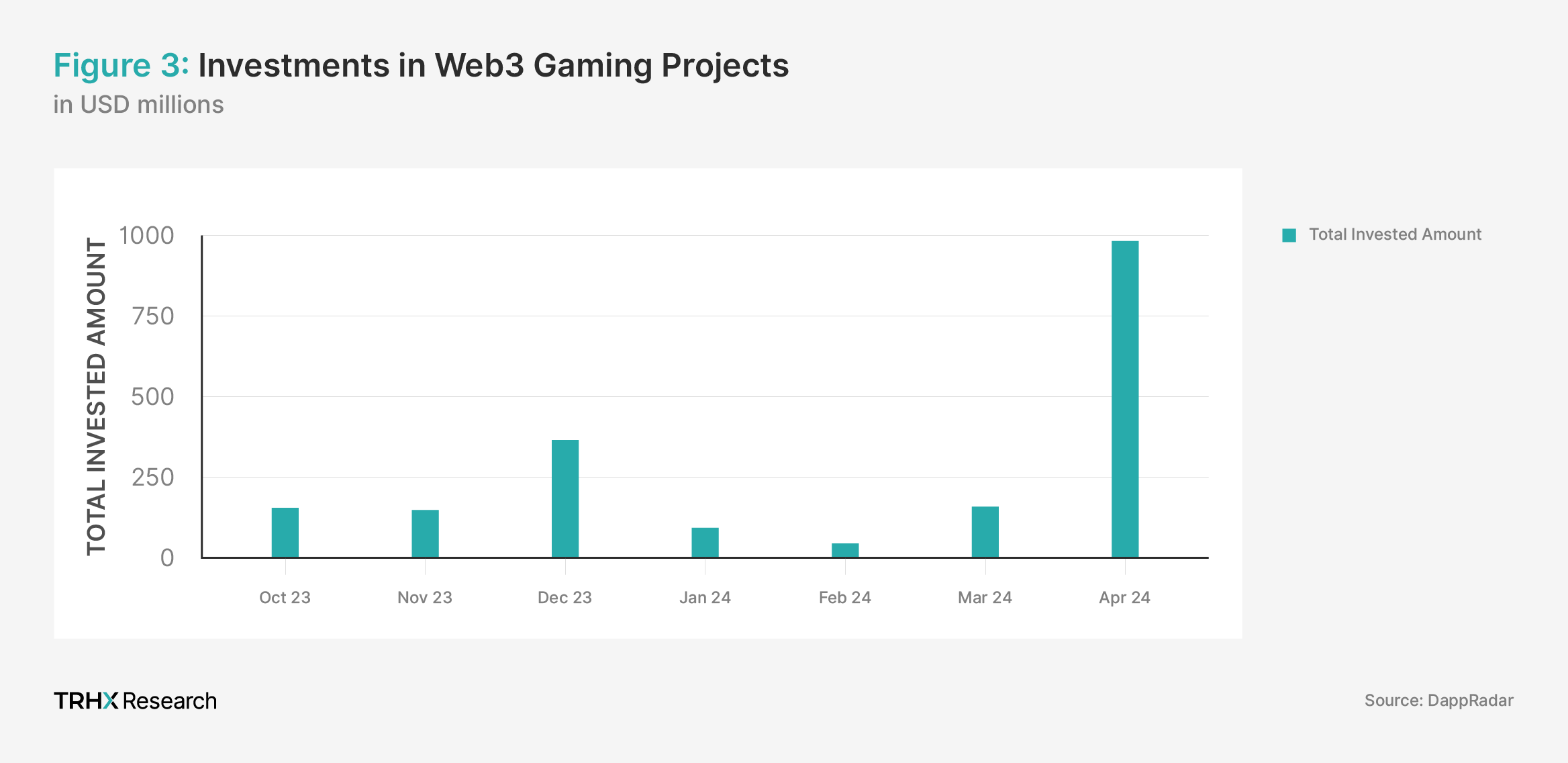
Dominating User Metrics: Gaming Leads the Crypto Sector
On the user front, on-chain data from Dappradar as of June 2024 has also shown that gaming continues to dominate a significant portion of the Web3 industry’s activity. According to one of its reports, gaming is one of the primary growth drivers for the crypto industry, accounting for almost half of the total on-chain activity in 2022. With continued investments, a growing player base, and increased activity, gaming is poised to be the primary medium for bridging the gap between traditional users and the blockchain industry.
Specifically, in terms of unique active wallets (UAWs), the blockchain gaming sector outperforms DeFi and is nearly 15% higher than social dApps, which was the second runner-up. As such, gaming projects have shown an even more dominating stance by user activeness, contributing 31% more active users than even crypto exchanges. This data highlights the popularity of the blockchain gaming industry, even during the bear market. With the overall market sentiment turning bullish and further institutional attention anticipated from the ETH spot ETFs, it is reasonable to expect that the blockchain gaming sector will continue to rise.
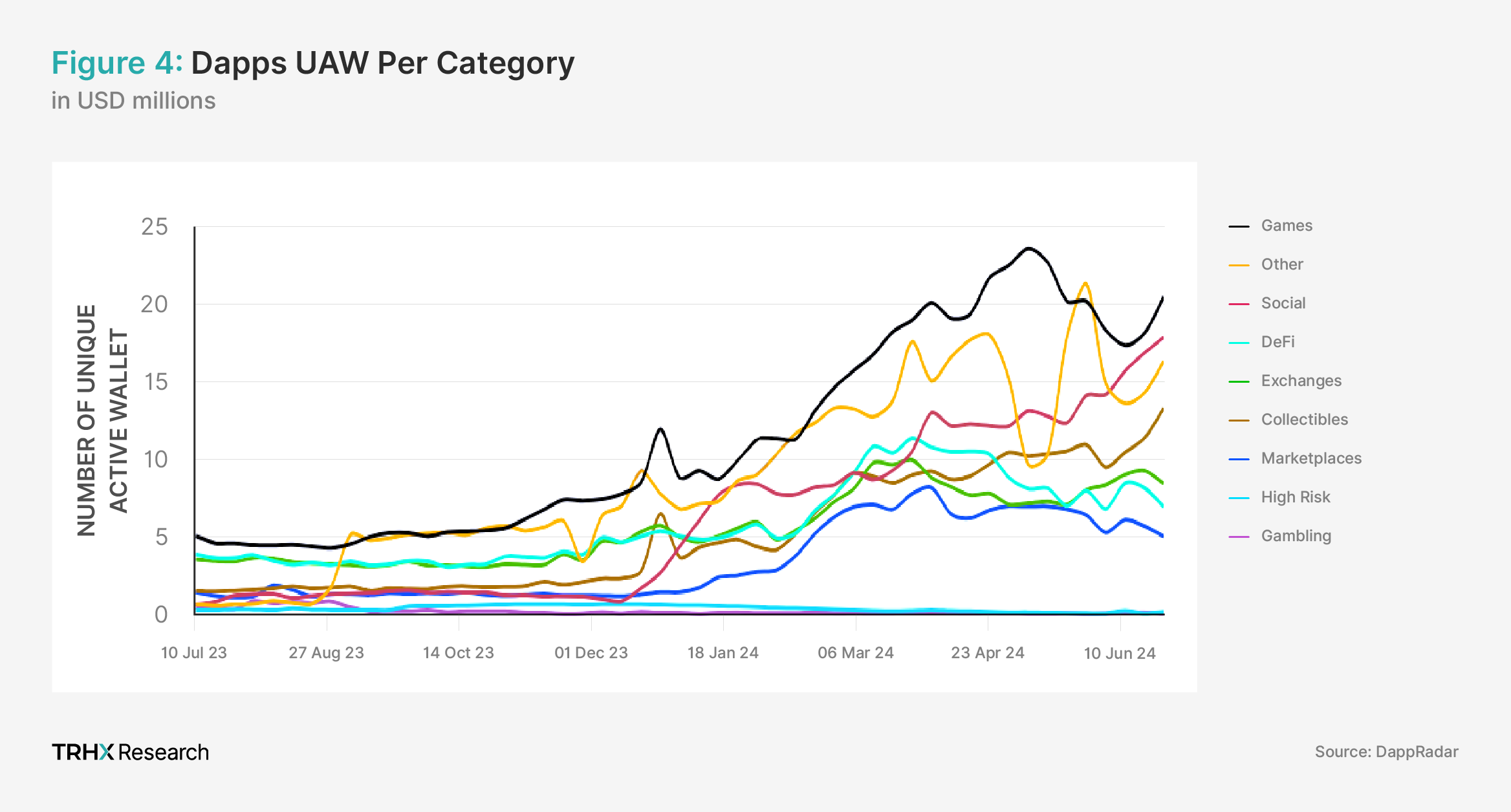
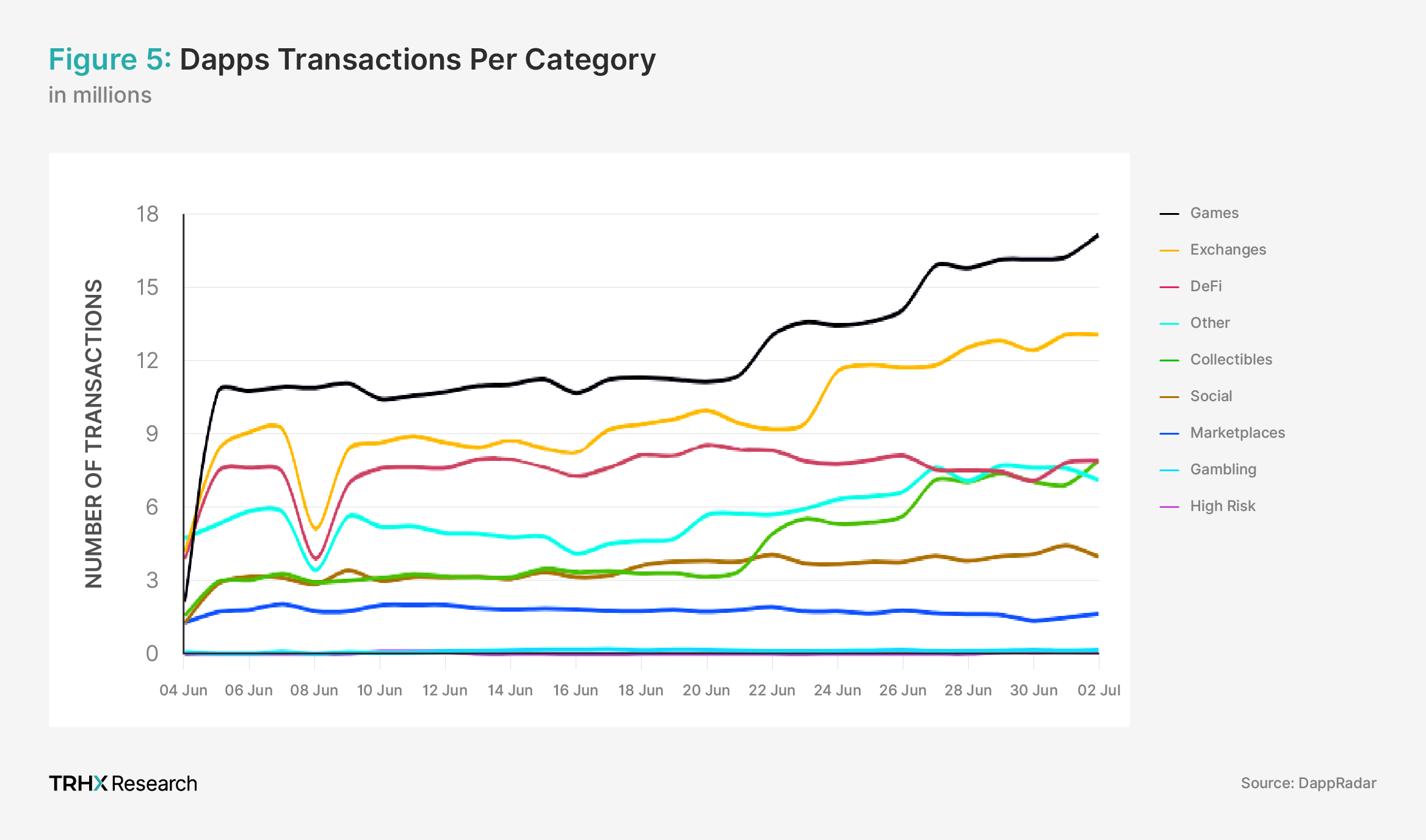
Main Players in the Metaverse Game
Now that we have established the growing interest in the Metaverse sector, let’s discuss the two leading players that have dominated the industry – The Sandbox and Decentraland. In terms of land ownership, The Sandbox has the largest market share at 34.7%, followed closely by Decentraland at 12.7%. When it comes to trading volume, both Decentraland and The Sandbox combined make up a significant portion, with The Sandbox capturing a substantial market share of 75% in June 2024. Let’s examine the reasons behind the success of these two players.
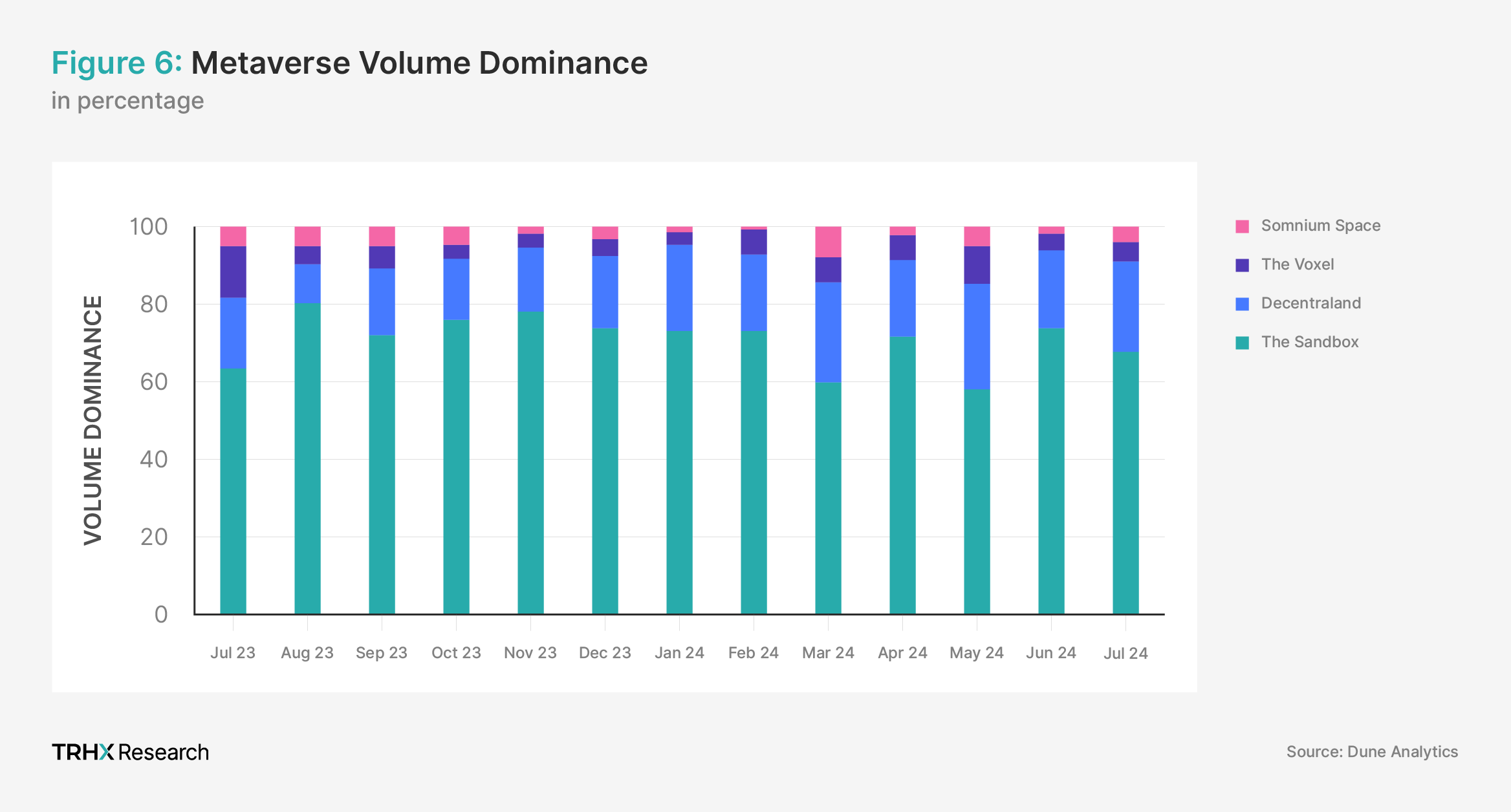
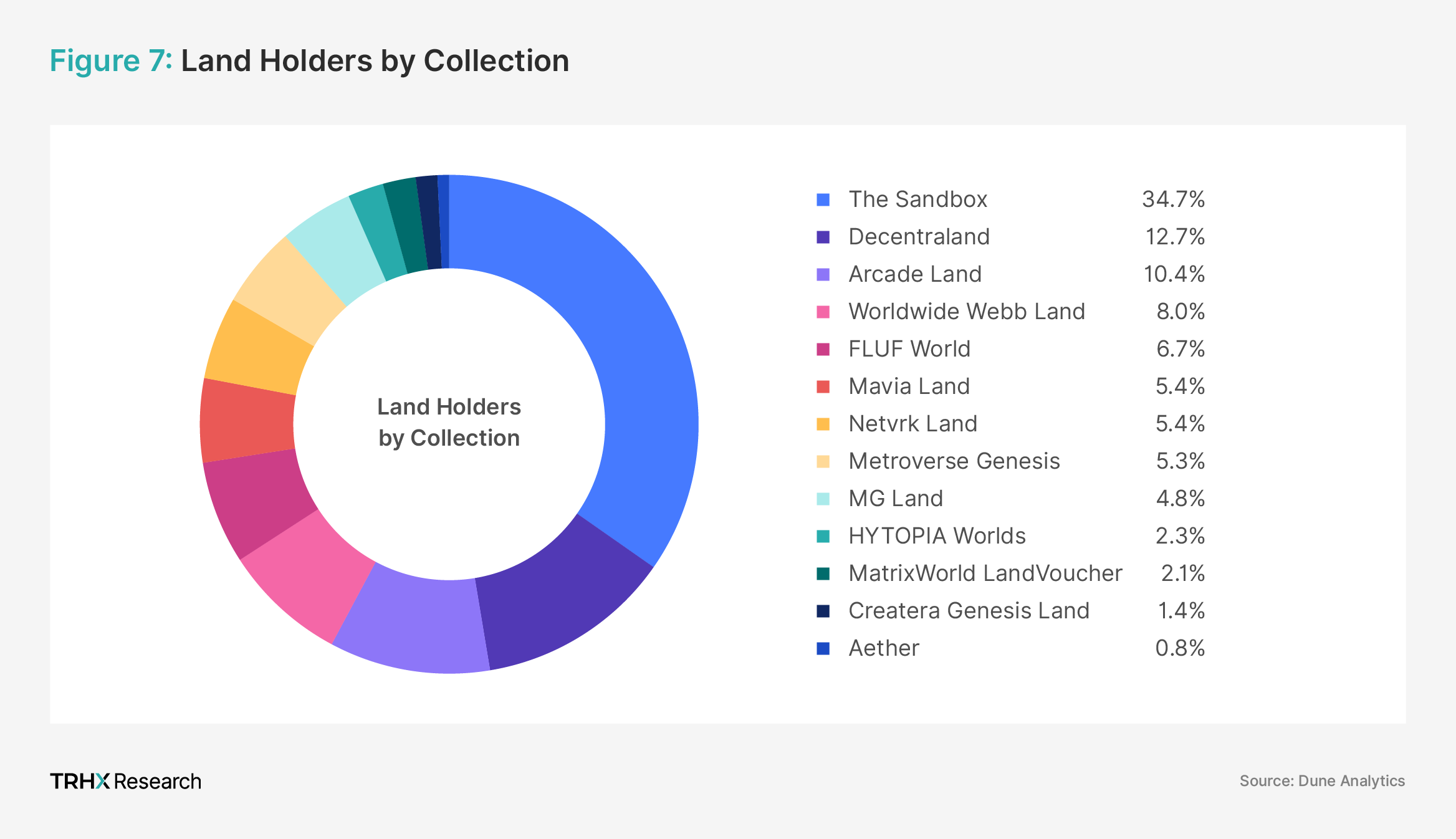
The Sandbox has achieved a strong standing within the Metaverse sector because it was an early adopter and made significant contributions to the space. Originally started in 2011 as a mobile game, The Sandbox has integrated blockchain technology into its metaverse gaming experience since 2018. Starting with Ethereum, The Sandbox has quickly expanded to include Polygon, fulfilling the vision of a multi-chain metaverse experience.
On the other hand, Decentraland officially launched in February 2020 as a virtual reality platform powered by the Ethereum blockchain. This launch also positioned Decentraland as one of the early adopters in the metaverse space, similar to The Sandbox, which also made significant early contributions to the development of the metaverse concept. As such, Decentraland has also amassed a large market share and is similarly powered by the Ethereum and Polygon blockchain, where users can create, experience, and monetize content and applications.
But where are the defining characteristics of each of these platforms? Let’s take a look:
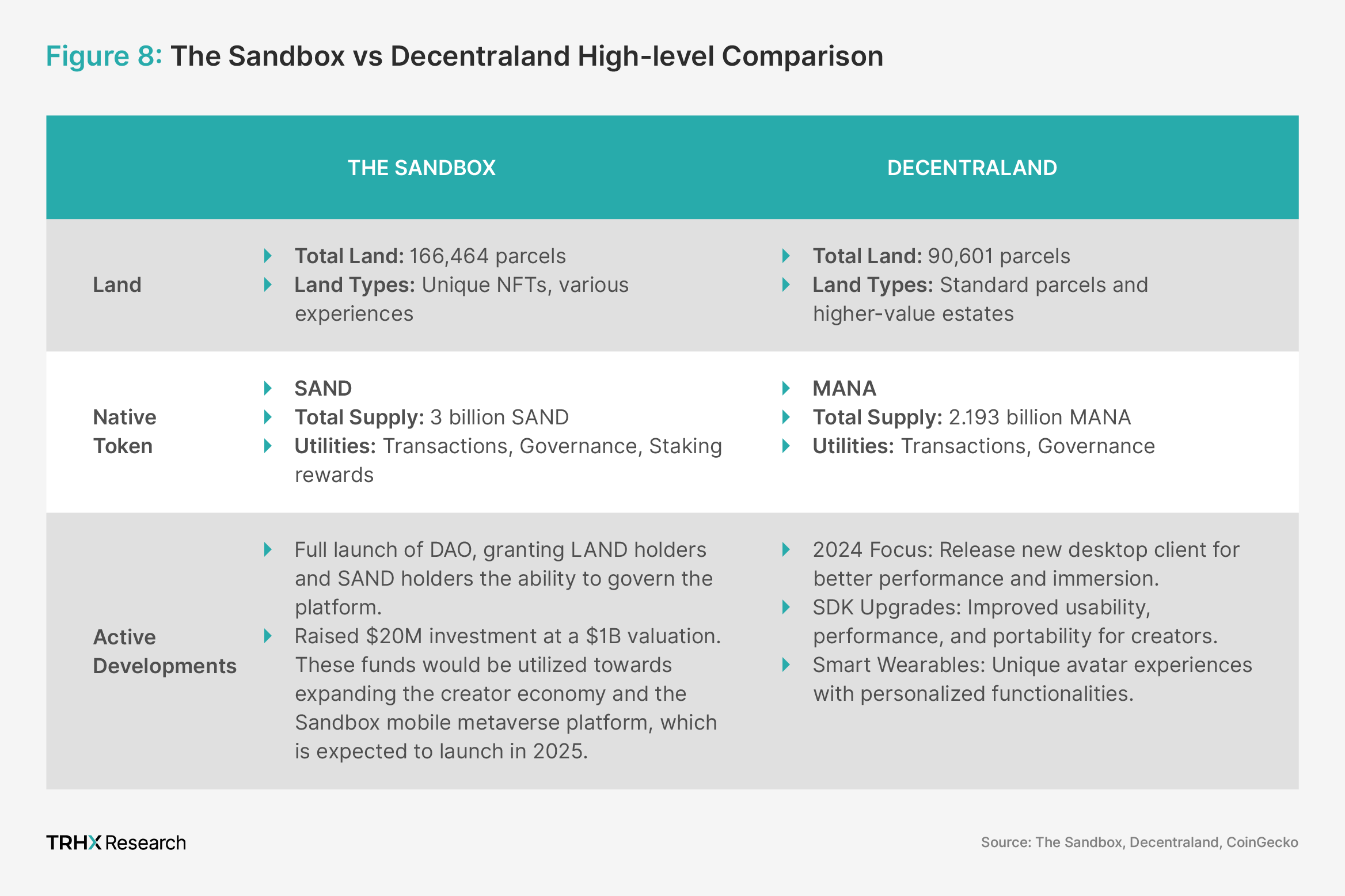
Unpacking The Metaverse Business Model
So, how do metaverse projects ensure the sustainability of their economies? To answer this, let’s delve deeper into the business models of Web3 Metaverse projects. Essentially, Web3 metaverse projects predominantly revolve around digital land transactions, content creation, and the strategic utilization of their native tokens. These elements shape their economic foundations and drive innovation within the metaverse experiences.
Land Sales
Virtual land sales are the initial and often primary revenue stream for Metaverse platforms. In these digital worlds, parcels of land are represented as NFTs, ensuring each piece is distinct and securely owned. The scarcity of these plots, maintained by limiting their total supply, creates a dynamic secondary market available on most NFT marketplaces.
The land model generates significant upfront capital for the platform developers and establishes a vested user base. Early adopters are typically the first creators and entrepreneurs in the Metaverse, setting the stage for the ecosystem’s growth and the accrual of social and economic capital.
Experience Creation on Owned Land
Ownership of virtual land allows users to build a variety of experiences, from games and social spaces to virtual storefronts and interactive art installations. Virtual land’s capabilities are critical as they shift users’ roles from mere participants to active creators and stakeholders in the ecosystem. The ability to monetize these experiences—whether through ticket sales for events, charges for services, or fees for interactive activities—turns virtual real estate into a potentially lucrative investment.
The diversity of these creations drives platform engagement, making each Metaverse a continuously evolving and expanding universe. Platforms like The Sandbox and Decentraland provide robust tools that lower the barriers to creating complex, interactive environments, ensuring that anyone with a creative vision can bring their ideas to life.
Transactional Fees and Token Use
Payment tokens are deployed on Metaverse platforms to facilitate economic activity within these virtual environments. These tokens are multifunctional, serving as the medium of exchange, a measure of value, and often, a tool for governance within the platform.
For example, Decentraland’s MANA token and The Sandbox’s SAND token are used to purchase land and assets, pay for goods and services, and participate in decisions that shape the platform’s future. This use of tokens ensures liquidity within the Metaverse economy. Meanwhile, the platform takes a percentage of the transaction value, ensuring its operational sustainability.
A Dynamic Economy
The integration of these elements—land sales, user-generated content, and token use—creates an economy that encourages ongoing investment and engagement for both creators and users. As such, a portion of the transaction fees generated within the platform is often redistributed to fund community projects or platform development.
Additionally, most Metaverse platforms have incorporated DAOs into their governance models, allowing token holders to vote on key issues within the platform and decide the future developments of the Metaverse. This gives additional utility to the otherwise payment tokens.
Standout Features of Major Metaverse Platforms
Decentraland
Now that we’ve covered how each of these platforms works, let’s talk about each of their standout features to determine what has contributed to their success. Decentraland stands out in the metaverse landscape through its integration of music and art, creating immersive experiences that attract artists, musicians, and enthusiasts. Here’s an overview of Decentraland’s standout features in these domains:
Decentraland – Music and Art
Firstly, Decentraland offers virtual spaces where artists can display their work in a digital format. These interactive galleries allow visitors to explore the artwork in a 3D environment. For example, as a part of the Decentraland Art Week, MESHfair is a virtual art fair showcasing immersive works by international artists. It features 3D, metaverse, and VR art curated by leading galleries such as Unit London and OFFICE IMPART. This event highlights the platform’s ability to host large-scale, interactive art exhibitions, bringing together artists and audiences from around the world.
In these art fairs, artists can auction their digital artwork directly to collectors. These auctions are conducted using MANA, providing a seamless transaction process. Decentraland has hosted exhibitions featuring well-known artists, which helps to attract a larger audience and provides a platform for emerging artists to gain exposure.
Lastly, Decentraland also hosts a virtual music festival called Decentraland Music Festival. Decentraland Music Festival featured prominent headliners like Bjork and Ozzy Osbourne, focusing on pioneering and digital-native performances that spotlight Decentraland and its vibrant community. Attendees can expect an alternative reality crafted by 16 award-winning teams of virtual creators and game designers, all while embracing the festival’s core values of radical self-expression, communal growth, and artistic renewal. The music festival lasts three days and will host more than 80 interactive performances, games, and events. It is free and open to all, with no VR headset required, making it accessible to a global audience.
These events are poised to draw new users to the Decentraland, as fans flock to support their favorite artists. The trend of virtual music concerts is gaining momentum, exemplified by Fortnite‘s highly successful concerts featuring Travis Scott. With Decentraland at the forefront of integrating music and art into the VR space, this feature is likely to pave success for them in the future.
Decentraland – Wellness
Additionally, the firm focuses on wellness. In terms of wellness, Decentraland strongly emphasizes mental, emotional, social, and spiritual well-being. Decentraland hosts an annual Wellness Week, a festival designed to recharge, reset, and refocus its community. This event offers over 40 live keynote sessions and events alongside 16 innovative experiences and interactive games.

During Wellness Week, Decentraland hosts a series of activities, events, and initiatives focused on promoting the health and well-being of its community. Participants can immerse themselves in unique 3D wellness experiences and compete for prizes totaling $15,000 in value, including land awards. Decentraland has extended invitations to 3D creators, game studios, and wellness enthusiasts to participate in this event. With no entry costs or skill requirements, it provides an open platform for creative individuals from the Web3 community to showcase their Metaverse creations.
The Sandbox
Moving on to The Sandbox, the standout feature of The Sandbox is its ability to generate a robust creator’s economy, empowering users to create, build, buy, and sell digital assets in the form of games and experiences within its virtual world, all without the need for coding knowledge. Additionally, The Sandbox has formed significant partnerships with key stakeholders, capturing the market’s mindshare and further enhancing its appeal.
The Sandbox – Marketplace for Retail Gamers and Professional Studios
The Sandbox provides a no-code Game Maker tool that allows users to create and design their own games and experiences without needing advanced technical skills. The Game Maker allows for ease of game development, enabling a broader range of creators to participate. In addition, they can use The Sandbox’s VoxEdit 3D modeling tool to create and animate 3D objects, which can then be turned into NFTs and sold on The Sandbox’s marketplace and external sites like OpenSea. Several users make use of this marketplace to sell their created items and thus generate revenue for themselves. Users can earn SAND tokens by participating in the ecosystem — creating content and engaging in other activities — which can be used further within the platform or traded on exchanges.

The Sandbox – Playable Events and Reward Opportunities in The Sandbox
The Sandbox also offers playable events where players can earn rewards in the form of SAND tokens. For example, in the event “Rabbids: Music vs Love,” players could join either the Music or Love team by purchasing a corresponding burnable NFT. The team with the most participants earned a proportionate share of the reward pool. Additionally, participants could earn bonus rewards, such as Rabbids NFTs, for voting on the theme of their Avatar Collection.
The Sandbox – Strong Commercial Partnerships
Beyond the creator economy, The Sandbox has also forged numerous high-profile partnerships with globally recognized brands and celebrities. The Sandbox boasts over 800 partnerships with a diverse range of globally recognized brands and celebrities. These include collaborations with entertainment giants such as Warner Music and Ubisoft and iconic figures like Snoop Dogg, Deadmau5, and Atari. These partnerships enhance the platform’s visibility and attract a wider audience by integrating popular culture into the metaverse.
From these partnerships, various forms of experiences are created, ranging from virtual concerts and fashion shows to interactive games and themed environments, providing diverse and engaging content for users. For instance, Snoop Dogg has created a virtual version of his mansion within The Sandbox, where he hosts virtual concerts and exclusive events, allowing fans to experience his performances in an immersive digital setting.
High-end fashion brands like Gucci and Adidas have also leveraged The Sandbox to host virtual fashion shows. These events showcase their latest collections in a unique, interactive environment where users can purchase limited-edition NFTs representing virtual clothing and accessories.

More recently, the popular Japanese anime and manga series Attack on Titan is also set to join The Sandbox, creating an interactive “Attack on Titan Land” within its virtual world. The collaboration between The Sandbox and Attack on Titan will feature a Land sale, allowing users to purchase virtual real estate via NFTs. Attack on Titan has a massive fanbase, making this a significant move in blending popular culture with blockchain technology.
The Sandbox – Music and Art
The Sandbox has also distinguished itself in the metaverse arena through its notable integration of music and art. One of its standout features is the partnership with Warner Music Group (WMG), which has led to the creation of a unique music-themed world within The Sandbox. The Sandbox’s collaboration brings concerts and immersive musical experiences featuring top artists like Bruno Mars, Twenty One Pilots, and Ed Sheeran to the metaverse, offering new ways for artists to engage with fans and generate revenue.
For example, Snoop Dogg has been a prominent figure in The Sandbox, releasing a metaverse music video and planning virtual concerts within his virtual estate. These events provide a new platform for artists to perform and interact with fans in a way that defies real-world limitations.
In conclusion, The Sandbox has established itself as a leading platform in the metaverse by fostering a robust creator economy and forming significant partnerships with globally recognized brands and celebrities, which enhance its visibility and user engagement. These multifaceted features collectively contribute to The Sandbox’s growing reputation and potential dominance in the industry.
$SAND: An Undervalued Gem In the Metaverse Sector
As the metaverse expands its digital horizons, The Sandbox’s SAND and Decentraland’s MANA emerge as pivotal tokens shaping virtual landscapes with distinct visions. Understanding their respective valuations sheds light on the evolving narrative of how virtual spaces are valued in today’s digital economy. Let’s delve into a comparative analysis to uncover what drives the valuation disparities between SAND and MANA in this growing metaverse frontier.
As governance tokens, the fair valuation of SAND and MANA hinges on their ability to foster vibrant, engaging ecosystems within their respective metaverses. These tokens derive their fundamental values from their roles as conduits for communities within The Sandbox and Decentraland, respectively. Central to this valuation are metrics that capture the metaverse’s network effects, such as the number of experiences created by content creators and the number of active wallets (as a proxy for users). These gauge platform activity and reflect the supply and demand within these virtual economies, serving as pivotal indicators of user engagement and community growth, essential for assessing the long-term viability and intrinsic value of SAND and MANA in the competitive metaverse landscape.
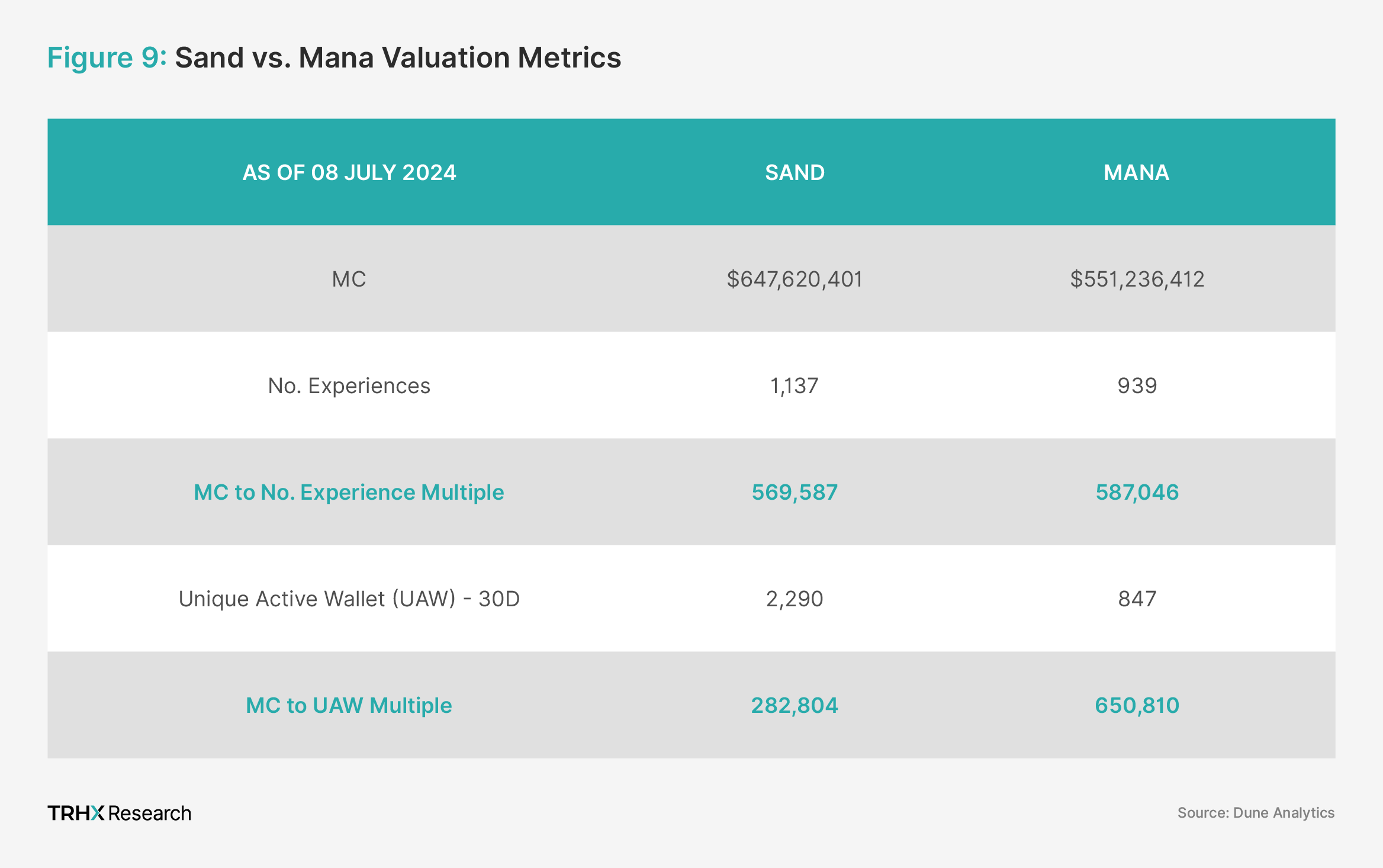
At their core, SAND and MANA represent two leaders within the metaverse sector, with comparable market caps and standing as pillars of the sector. When evaluating their valuations based on the number of experiences created on each platform, both SAND and MANA appear reasonably valued.
When examining unique active wallets over a smoothed 30-day period, The Sandbox emerges as a frontrunner with significantly higher user engagement than Decentraland. This metric reflects The Sandbox’s broader appeal and active community and suggests that The Sandbox is able to drive sustained platform activity. In terms of valuation relative to this user metric, The Sandbox appears markedly undervalued compared to Decentraland. When adjusted for market cap, SAND appears to be undervalued by more than 2X relative to MANA, signaling a potentially compelling opportunity.
Token Activity Analysis: Beyond the Surface
To assess user activity in The Sandbox and Decentraland, we also examined their token transaction metrics, considering that both SAND and MANA serve as payment tokens within their respective ecosystems. The Utilization Ratio is used as a metric that is calculated by dividing the number of transactions by the number of active users, providing an average transaction per active wallet over the observed period. Our analysis revealed that The Sandbox maintains a higher Utilization Ratio of 4.44, compared to Decentraland’s 3.76 since the initial launch of the token.
Moreover, when examining specific networks, SAND on the Polygon network shows an even more pronounced Utilization Ratio of 5.95 compared to MANA’s 4.18, marking a more than 40% difference. This disparity indicates that The Sandbox’s active users are making more transactions on average than Decentraland’s active users, suggesting stronger fundamentals for its current valuation.
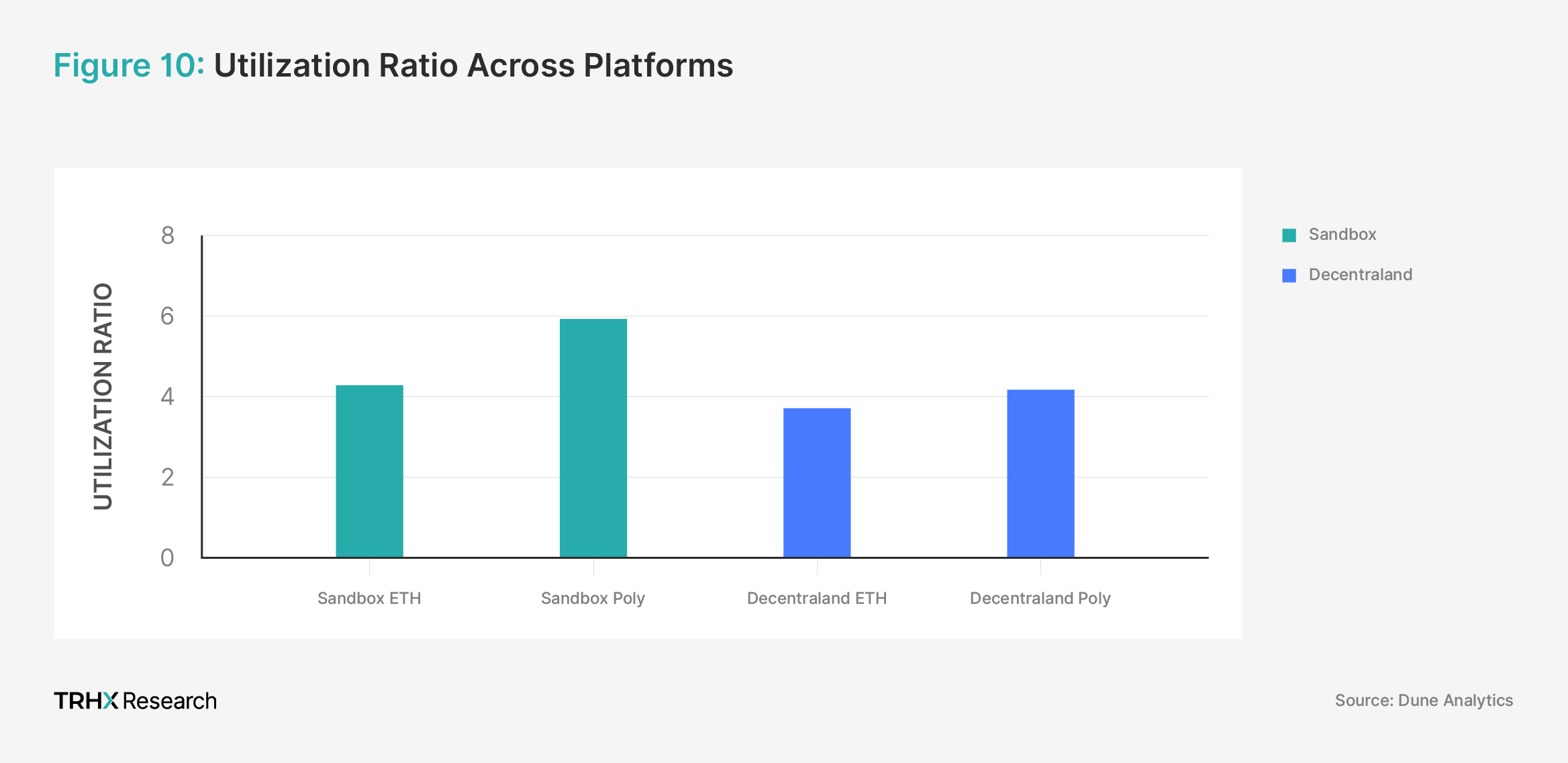
User Loyalty Matters
Since both projects feature core assets such as Land, native tokens for payments and governance, and in-experience assets, we may take a deep dive into each asset type to determine the distinct segments of their user base.
Land Holders are the pioneering investors in the metaverse, drawn by the vision of creating and curating virtual experiences. Their ownership signifies a commitment to the long-term development of the metaverse through content creation.
Token Holders, encompassing speculative traders and active users, play a pivotal dual role. They believe in the metaverse’s future potential and actively participate in its economy by purchasing in-game items and expanding their virtual holdings. A subset of token holders also engages in on-chain governance, contributing to the decision-making processes that shape the metaverse’s future trajectory.
In-Game Asset Holders represent the end-users of metaverse experiences, utilizing assets within specific virtual environments for decorative and functional purposes. Their engagement directly impacts the utilization and adoption of virtual spaces within the metaverse.
As such, to gauge community strength comprehensively, an effective Loyal User metric can be established. This metric involves wallets that hold all three types of assets—land, native tokens, and in-game assets. These wallets signify a deeper level of engagement and commitment to the metaverse as individuals who actively create content on their lands, transact using native tokens for in-game purchases, and participate in governance activities such as voting.
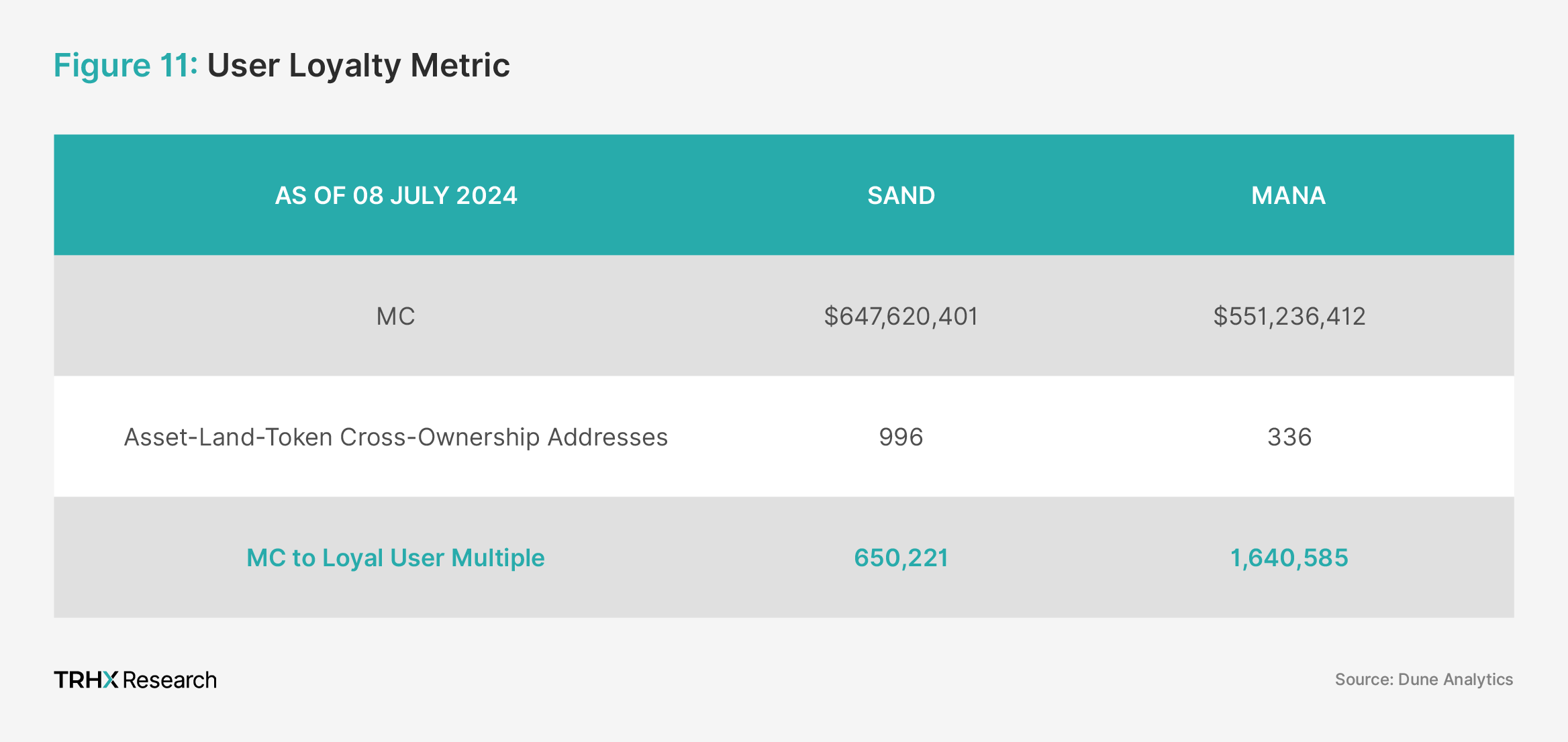
Through on-chain analysis, it has been observed that The Sandbox boasts nearly three times as many such wallet addresses as Decentraland. Despite having a comparable market capitalization to Decentraland, this significant disparity suggests that the SAND, the native token of the Sandbox metaverse, may be undervalued relative to its potential.
Future Selling Pressures?
While previous analyses focused on relative valuation metrics based on market caps, examining the tokenomics of SAND and MANA is essential for forecasting the Metaverse market’s future dynamics. Currently, 76% of SAND’s total supply is in circulation, with 88% already vested and full vesting expected by February 2025. This data indicates that the Company, Foundation, and investors have adopted a long-term perspective on the token, as they have retained their holdings despite having vested. Consequently, SAND faces limited selling pressure, and the Company and Foundation maintain healthy SAND reserves, supporting the game’s and ecosystem’s long-term development.
In contrast, MANA has a slightly higher percentage of tokens in circulation at 85%, but its vesting schedule extends significantly longer, with full vesting anticipated by March 2030. This extended vesting period means that while immediate selling pressure may be lower, the Foundation has fewer resources available in the near term.
Comparatively, recent launches of hot GameFi tokens this year show a different pattern, with low floating market caps but high fully diluted valuations (FDV). For instance, PIXEL, as one of the most hyped GameFi tokens of the year, has only 15% of its tokens currently unlocked, indicating substantial future selling pressures and potentially overvalued FDV.
Further on-chain analysis also reveals that despite enduring the recent bear market, the publicly known The Sandbox team and company reserve addresses continue to hold a substantial portion of the token supply, showing minimal movements or indications of selling beyond necessary operational expenses. This steadfast commitment displays the team’s confidence in the token’s value and long-term project vision. Such behavior demonstrates a strong conviction in the project’s potential and that SAND may be currently undervalued in the market. This strategic “hodling” strategy by The Sandbox team and associated entities contributes to the token’s stability and strengthens its long-term appeal.
Future developments
After conducting quantitative assessments of metaverse tokens, SAND stands out as potentially undervalued within the sector. Let’s explore qualitative catalysts driven by upcoming developments that could further bolster the bullish narrative surrounding the SAND token. By examining these potential future advancements and their implications, we can gain deeper insights into why SAND may represent a compelling opportunity in the evolving landscape of the metaverse.
Partnerships and Deals
Engaging in strategic deals and partnerships has been pivotal for The Sandbox in expanding its user base and ecosystem within the metaverse landscape. The Sandbox has consistently secured high-profile partnerships with global brands such as Snoop Dogg, The Walking Dead, and The Smurfs. On top of enhancing the platform’s visibility, these collaborations also drive significant user demand for immersive metaverse experiences. This symbiotic relationship creates a network effect where increased user engagement and demand for experiences incentivize content creators to develop more within The Sandbox platform. Consequently, this cycle boosts demand for SAND tokens and Land NFTs, further amplifying the platform’s network effects and solidifying its position as a leading player in the metaverse.
Moreover, The Sandbox’s proactive investment strategy in the GameFi sector underscores its commitment to enhancing the ecosystem. Year to date, The Sandbox has invested in four different companies, including Cross The Ages and Matera, focusing on gaming and creator economies. These investments not only diversify The Sandbox’s ecosystem but also potentially benefit token holders indirectly. Companies supported by The Sandbox may contribute to the metaverse by developing new experiences or improving existing ones using their technologies. The returns on these investments, bolstered by the market’s performance year to date, further enhance the fundamental strength of The Sandbox ecosystem and consequently contribute to the growth potential of the SAND token.
DAO Formation
The formation of a Decentralized Autonomous Organization (DAO) marks a significant milestone for any blockchain project, often signaling a new phase of growth and utility for its native token. In the case of The Sandbox, the establishment of its DAO represents a pivotal moment that promises to enhance the ecosystem’s bullish outlook. As DAOs enable decentralized governance and decision-making, they empower token holders to actively participate in shaping the platform’s future. This introduction of governance capabilities typically leads to increased token utility on top of its original purpose for transactions, fostering a stronger community engagement and bolstering confidence in the ecosystem’s long-term sustainability and growth potential.
Historical Trends
Drawing a parallel with Decentraland’s MANA token, which transitioned into a DAO structure in early 2020, provides insights into the potential impact of DAO formation on token performance. Historically, this shift was a strong catalyst for Decentraland’s price performance in subsequent years. Over 1.5 years following the year of the DAO’s launch, MANA significantly outperformed major cryptocurrencies like BTC and ETH, achieving returns exceeding 18x, with peaks surpassing 50x from early 2021. Notably, this period excludes external factors such as Facebook’s rebranding to Meta in October 2021, isolating the direct effect of DAO formation on MANA’s growth trajectory.
Given these observations, the formation of The Sandbox DAO could similarly catalyze growth for the SAND token in the months ahead. If the DAO proves to be as influential for The Sandbox as it was for Decentraland, we might anticipate a comparable surge in SAND’s value. However, it is crucial to note that the full impact of DAO implementation takes time to materialize. Participants need to join, contribute to the protocol, and engage in governance processes for the true potential of decentralized decision-making to unfold. This gradual process shows the transformative power of DAOs in enhancing token utility and community involvement within the metaverse ecosystem.
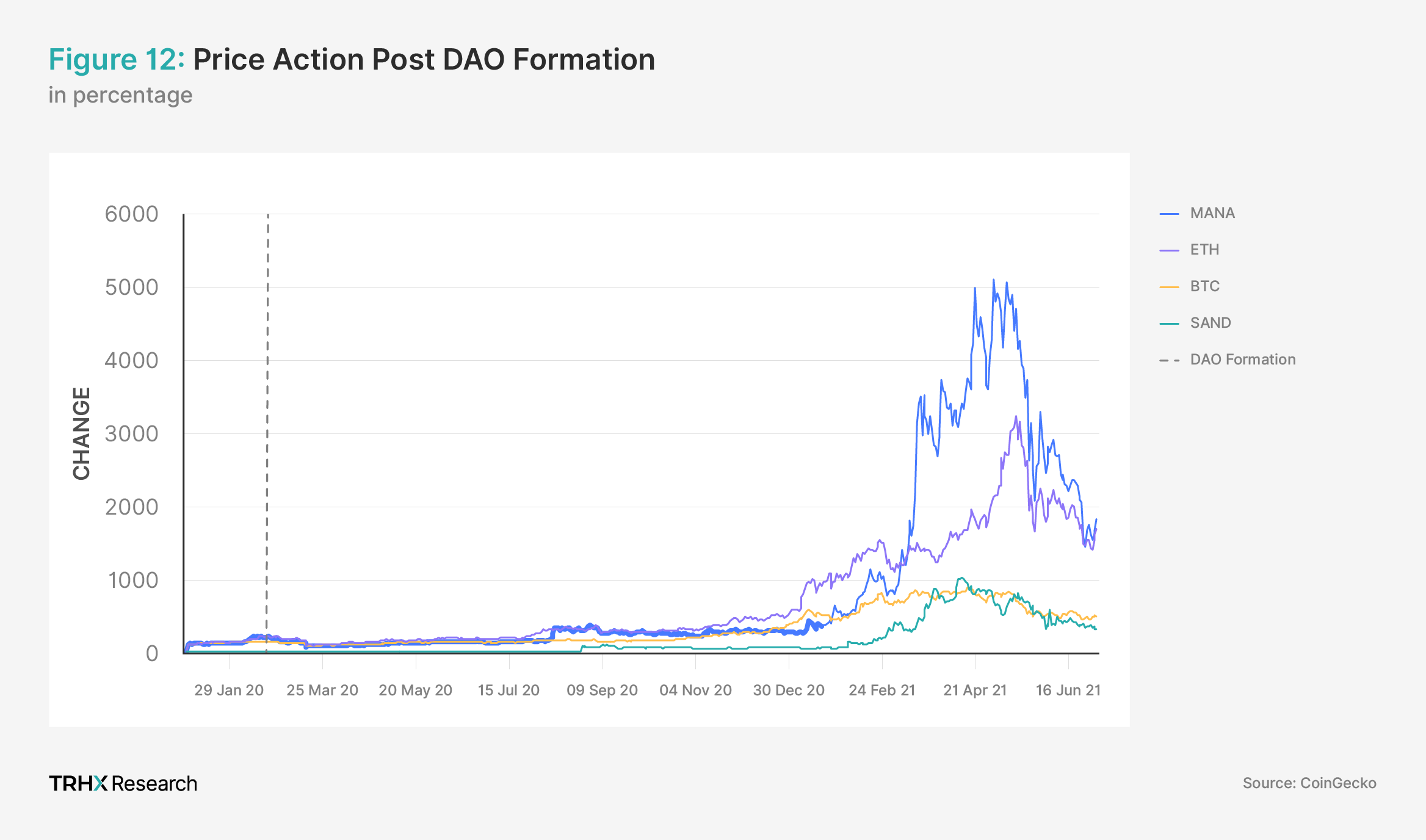
Initial SIPs and Their Potentials
With the implementation of the DAO and its forum, various discussions and proposals about potential improvements on The Sandbox platform are emerging, potentially providing value to The Sandbox ecosystem.
One prominent proposal is the “Magic Palette,” which aims to empower landowners with the ability to transform their lands into immersive, playable experiences without requiring any design experience. Magic Palette seeks to streamline the creation process, enabling more landowners to craft unique experiences with minimal resources. As a result, landowners can monetize their opportunities more effectively, while users of The Sandbox benefit from a wider variety of experiences. Community sentiment towards this proposal has been overwhelmingly positive, as it promises to lower the barrier to entry for users who face difficulties in designing their land.
Another critical proposal focuses on enhancing server performance. This SIP addresses the need for technical improvements essential for scaling The Sandbox’s multiplayer functionalities. By aiming to decrease latency and improve scalability, this proposal ensures that the infrastructure can handle increased player loads efficiently, thereby enhancing the overall user experience.
Additionally, there are broader proposals advocating for the creation of a transparent and accessible development roadmap for The Sandbox. This SIP seeks to outline future updates for key tools and platforms within the ecosystem, including the Game Client, VoxEdit, Launcher, Game Maker, and the official website. The goal is to garner more community feedback, ensuring users can contribute to and stay informed about ongoing developments.
Conclusion
In summary, the metaverse is entering a new phase of growth after enduring a prolonged crypto winter. Platforms exhibiting robust performance metrics and proactive development strategies are emerging as promising investment opportunities. The Sandbox, a prominent player in this landscape, seems undervalued when evaluating its metrics for user engagement and land ownership, both strong indicators of a vibrant and expanding platform. These metrics emphasize The Sandbox’s current standing as a dominant player. Moreover, The Sandbox’s strides in IPs, governance via its DAO, and strategic partnerships are set to strengthen its market position even further.
By effectively combining the user experience capabilities of Web2 with the decentralized and ownership-driven features of Web3, the metaverse is forging a new digital economy where users are more than just consumers but rather creators and stakeholders. The integration of gaming, social interactions, and commerce within these virtual spaces is unlocking new opportunities for economic and creative endeavors.
Disclaimer
This publication is provided for informational and entertainment purposes only. Nothing contained in this publication constitutes financial advice, trading advice, or any other advice, nor does it constitute an offer to buy or sell securities or any other assets or participate in any particular trading strategy. This publication does not take into account your personal investment objectives, financial situation, or needs. TRHX does not warrant that the information provided in this publication is up-to-date or accurate.
Hyperion by TRHX reimagines workflows for digital asset traders and investors looking for actionable market and portfolio data. Contact us if you are interested! Otherwise, check out TRHX Research and TRHX Pulse for in-depth research.
